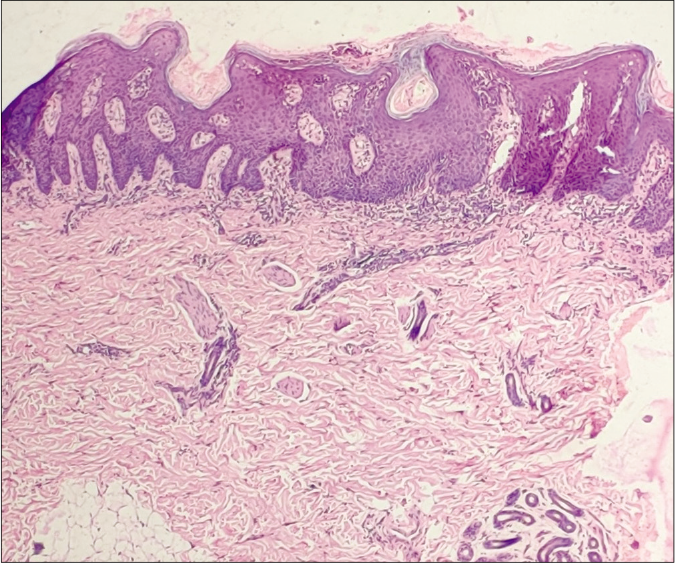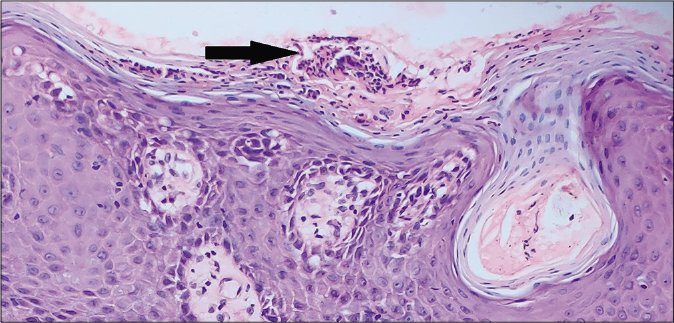Translate this page into:
Psoriasis as Wolf ’s isotopic response over BCG scar
Corresponding author: Dr. Ekta Mishra, Department of Skin and VD, MKCG Medical College and Hospital, Berhampur, Odisha, India. mishraekta1126@gmail.com
-
Received: ,
Accepted: ,
How to cite this article: Mishra E, Patnaik S, Nayak S, Rout AN, Sethukumaran AG, Sahoo RL. Psoriasis as Wolf’s isotopic response over BCG scar. Indian J Dermatol Venereol Leprol 2021;87:712-4.
Sir,
Wolf’s isotopic response, first introduced by Wolf et al., refers to the development of a new unrelated dermatosis at the healed site of a previous dermatosis.1 The commonly reported second diseases are urticaria, lichen planus, psoriasis, infections such as molluscum contagiosum, fungal granuloma, rosacea, morphea and granuloma annulare.2 Various dermatoses that can develop on a Bacillus Calmette-Guerin (BCG) scar site include, cutaneous tuberculosis, keloids, sarcoidosis and nodular hidradenoma but development of psoriasis over it is very rare. We describe a case of psoriasis developing on a healed BCG scar site in a child.
A 1.5-year-old healthy girl, born out of non-consanguineous marriage, presented to the skin department of MKCG Medical College and Hospital, Berhampur, Odisha, with a single, reddish, elevated, scaly lesion on the left upper arm, noticed by the mother five months after birth. There was a history of BCG vaccination, 24 h after birth, at the site. Subsequently, the injection site became swollen, red and ulcerated in 3–4 weeks for which the mother consulted some local physician and applied topical medication (nature unknown). The lesion healed with scar formation by of 8–10 weeks. After about three months, the mother noticed a grain sized reddish, elevated scaly lesion over the scarred area which gradually increased to attain the present size, associated with itching. Topical antifungals were applied but there was no improvement in the lesion. Family history was noncontributary.
On examination, a single, well-demarcated, erythematous, indurated plaque of size 3 × 3 cm with thick adherent white scales, was present on the left deltoid region on the site of BCG scar with sparing of other areas of the body [Figure 1]. Grattage test was done over the lesion and Auspitz sign was positive. Based on the clinical findings, psoriasis and psoriasiform lupus vulgaris were considered in differential diagnosis. All routine investigations were within normal limits. Tuberculin test was not done, due to its non-specific nature.

- Single, well-demarcated, erythematous, indurated plaque of size 3 × 3 cm with thick adherent white scales on the left deltoid region, on the site of BCG scar
Histopathological examination of lesional skin biopsy revealed acanthosis, parakeratosis, hypogranulosis, regular elongation of rete ridges, collection of neutrophils within the parakeratotic layer with vascular proliferation in papillary dermis and mild-to-moderate chronic inflammatory cell infiltrates in superficial dermis, consistent with psoriasis [Figures 2 and 3]. With a final diagnosis of psoriasis vulgaris (possibly due to Wolf’s isotopic response) on BCG scar, topical calcipotriol (0.005%) for twice daily application was started. After one month of treatment, the lesion showed improvement.

- Scanner view showing acanthosis, parakeratosis, elongation of rete ridges, hypogranulosis, collection of neutrophils within the parakeratotic layer with vascular proliferation in papillary dermis and mild-to-moderate chronic inflammatory cell infiltrates in superficial dermis (H&E, 40×)

- Magnified view showing collection of neutrophils within the parakeratotic layer that is Munro’s microabscess (H & E, ×400)
The various possible hypotheses formulated to explain this unusual phenomenon include viral, neural, immunological and vascular etiologies.2 However, the most plausible composite hypothesis is “locus minoris resistentiae,” or immunocompromised cutaneous district which refers to a focus of dysregulated immunity, caused by alternation in release of neuropeptides or defect in lymphatic flow, occurring secondary to any local cause such as herpetic infections, radiations, burns, intradermal vaccinations or stasis in lymphatic flow.3 This local area serves as a site for the development of secondary infections, tumors or immune-mediated reactions.3
Host immune cells recognize BCG antigen and stimulate production of pro-inflammatory cytokines such as tumor necrosis factor-alpha, interleukin 1 and 6.4 Antigen-presenting cells in skin present this antigen to the T-lymphocytes leading to T-cell priming and activation of acquired immunity.4 This activated adaptive immunity together with dysregulated local immunity can provide a trigger for the development of immune mediated disorders like psoriasis. Takayama et al., reported occurrence of tuberculid eruptions with psoriatic dermatitis following BCG vaccination in a six-month-old baby. This was confirmed based on the presence of epithelioid granuloma in dermis, which improved spontaneously without any medications.5
Koebner response, a closely related phenomenon, needs to be differentiated here. In Koebner phenomenon, there is a development of similar cutaneous lesions in the setting of an already existing dermatosis, following any trauma; whereas in Wolf’s isotopic response, there is a development of a new dermatosis localized to the particular site of a previously healed dermatosis without appearance of those similar lesions elsewhere in the body.2 Further studies are necessary and reporting of such similar cases will be helpful in differentiating these two responses.
Here, we report a case of psoriasis developing on a BCG scar in a 15-month-old baby, five-month post-vaccination, possibly due to Wolf’s isotopic response. This unusual, rare case can be explained by the hypothesis of local immune dysregulation with stimulated innate and acquired immunity following vaccination.
Declaration of patient consent
The authors certify that they have obtained all appropriate patient consent.
Financial support and sponsorship
Nil.
Conflicts of interest
There are no conflicts of interest.
References
- Wolf's isotopic response: Report of a case and review of literature. Indian J Dermatol. 2014;59:275-82.
- [CrossRef] [Google Scholar]
- Ruocco's immunocompromised cutaneous district. Int J Dermatol. 2016;55:135-41.
- [CrossRef] [Google Scholar]
- BCG-induced cross-protection and development of trained immunity: Implication for vaccine design. Front Immunol. 2019;10:2806.
- [CrossRef] [Google Scholar]
- Psoriatic skin lesions induced by BCG vaccination. Acta Derm Venereol. 2008;88:621-2.
- [CrossRef] [Google Scholar]





